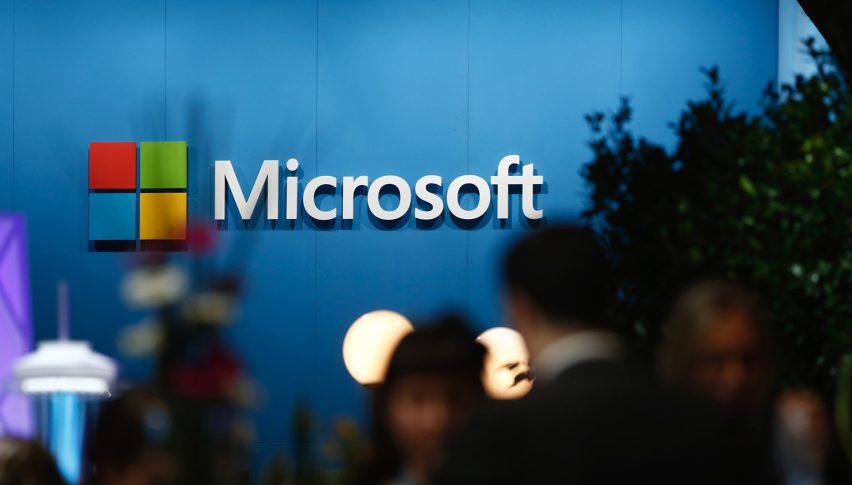MSFT Stock Turning Point as Selling Pressure Meets A Key Support Level
As worries about strategy, costs, and sustainability take the place of excitement, Microsoft's slide is indicative of a larger reevaluation

Quick overview
- Microsoft's stock has declined by approximately 7.5% since late October, reflecting growing investor skepticism about AI valuations and rising costs.
- The company's recent struggles have disrupted its previously strong market position, with shares failing to maintain momentum above $550.
- Concerns over insider selling and the scale of AI-related expenditures have added to investor unease, raising questions about profitability and strategy.
- Microsoft is navigating a complex landscape of expanding AI partnerships while facing internal challenges and external pressures that complicate its growth narrative.
Live MSFT Chart
[[MSFT-graph]]As worries about strategy, costs, and sustainability take the place of excitement, Microsoft’s slide is indicative of a larger reevaluation of risk.
A Sharp Turn In Investor Confidence
A combination of accelerating expenses, internal turbulence, and renewed fear that artificial intelligence is being significantly overvalued has pushed Microsoft into a noticeable pullback. Throughout November, the stock has struggled to regain its footing after months of relentless optimism. A market that once viewed Microsoft as nearly untouchable has begun to second-guess that narrative, introducing a new layer of caution into what had long been one of the most stable uptrends in global equities.
The slowdown in sentiment began in late October, when shares hovered near the $550 level. Since then, Microsoft has retreated by roughly 7.5%, with its decline coinciding with a broader wave of skepticism sweeping through the AI sector. Despite a strong earnings report from Nvidia, investor attention shifted to the massive spending required to sustain artificial intelligence infrastructure. That realization created hesitation around megacap technology stocks, and Microsoft, sitting at the heart of the AI revolution, became a focal point for that unease.
Momentum Breaks After Record Levels
Not long ago, Microsoft was pushing into new all-time highs above $555, supported by strong quarterly results and faith in its dominant position in cloud and AI. However, repeated attempts to extend that breakout failed, encountering resistance around the $553–554 zone. The rejection was decisive. Shares reversed sharply, dropping below the $500 handle and slicing through several key moving averages in quick succession.
MSFT Chart Weekly – Sellers Test the 20 SMA
This sudden breakdown disrupted the perception of Microsoft as an unbreakable fortress. Selling pressure intensified, and confidence wavered as profit-taking accelerated. Market participants are now paying close attention to the area around $468, which has become a crucial battleground. The stock’s recent declines have stalled in this region, and support has held for several consecutive sessions, signaling that buyers are still present — though far less aggressively than before.
Key Support And Fragile Stability
From a longer-term perspective, the $470 area carries historical importance, having previously acted as resistance before becoming support. In addition, the 20-month moving average, which has helped underpin previous pullbacks, now sits in that same zone. The fact that the stock has repeatedly tested but not broken below this level hints at a possible attempt to stabilize and rebound.
If buyers regain control, the first upside targets would likely be a recovery toward the $485 region and then a retest of the psychologically important $500 level. Failure to maintain support, however, especially if the 20-month average gives way, would reinforce the view that sellers are still dictating the trend and that a deeper correction is unfolding.
Insider Activity And Strategy Concerns
Adding another layer of discomfort was the early-November sale by Vice Chair and President Brad Smith, who disposed of more than 30,000 shares in a transaction valued at nearly $16 million. While insider selling can occur for many personal or financial reasons, its timing amid a market pullback amplified unease among investors already on edge.
At the same time, Microsoft’s aggressive investment in artificial intelligence continues to spark debate. Although the company exceeded Q3 forecasts — reporting earnings of $3.72 per share on $77.67 billion in revenue — those results were partly overshadowed by the scale of AI-related spending. More than $3.1 billion was directed toward OpenAI initiatives alone, significantly impacting profitability. Management has also made it clear that elevated investment levels will persist, raising questions about how long margins can absorb that pressure.
Expanding Alliances And Rising Complexity
Microsoft is simultaneously deepening and diversifying its AI relationships. Alongside Nvidia, the company has increased its involvement with Anthropic, weaving Claude’s models into the Azure ecosystem. These partnerships are meant to strengthen Azure’s position as a critical AI platform, but they also reveal the increasingly complex and fragmented nature of Microsoft’s strategy in this rapidly evolving space.
Further complicating matters are signs of strain with OpenAI. Reports that OpenAI is exploring independent chip partnerships and potentially launching products that could overlap with Microsoft-owned LinkedIn have sparked speculation about shifting power dynamics. For an investor base that once viewed the OpenAI relationship as an unshakeable advantage, these developments introduce uncertainty about the future balance of control.
Additional Headwinds Emerge
Beyond AI investment concerns, Microsoft faces other challenges. Internal data leaks tied to AI tools have reignited debates about security and oversight. Xbox hardware sales have dropped sharply year-on-year, reflecting stagnation in a segment already under pressure. Meanwhile, employee protests related to defense-linked AI projects and international partnerships have added reputational and ethical questions to the mix.
Together, these forces point to a company entering a more complicated and more scrutinized chapter. Microsoft remains a technological powerhouse, but the narrative has shifted. Investors are no longer focused only on growth potential. Increasingly, they are demanding discipline, clarity, and proof that the enormous bets being placed on the future of AI can be matched by sustainable returns in the present.
- Check out our free forex signals
- Follow the top economic events on FX Leaders economic calendar
- Trade better, discover more Forex Trading Strategies
- Open a FREE Trading Account



